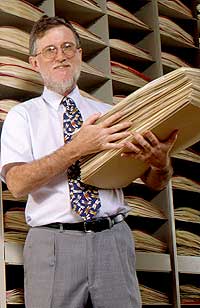 |
QUICK SEARCH
MO PROJECTS:
Africa
Asia/Pacific
Mesoamerica
North America
South America
General Taxonomy
Photo Essays
Training in Latin
America
MO RESEARCH:
Wm. L. Brown Center
Bryology
GIS
Graduate Studies
Research Experiences
for Undergraduates
Imaging Lab
Library
MBG Press
Publications
Climate Change
Catalog Fossil Plants
MO DATABASES:
W³MOST
Image Index
Rare Books
Angiosperm
Phylogeny
Res Botanica
All Databases
INFORMATION:
What's New?
People at MO
Visitor's Guide
Herbarium
Jobs & Fellowships
Symposium
Research Links
Site Map
Search
 | table of contents |
PROFILE: James C. Solomon | |
 |
Jim Solomon, curator of the herbarium, manages the storage, care and use of the Garden's collection. His research interests focus on the flora of the Bolivian Andes and studies of members of Vitaceae, the grape family, and Cactaceae, the cactus family.
Photo: Trent Foltz |
Secret of the Specimen ShelvesThe value of this huge collection is incalculable. "All we know about most of the world's organisms is a name, a description and samples in a collection," says Solomon. "Specimens are the raw data for our concepts about plants. They are an archive of natural history - as significant to our understanding of the natural world as cultural artifacts are to human history." But the specimens are not the end point of the herbarium, they are really the beginning, says Solomon. "All kinds of scientists ask questions of the herbarium - and the questions today are more diverse than ever. People in search of heavy-metal deposits have examined plants that accumulate these substances. Also, visiting entomologists have correlated our plants with species of insects. A hundred years from now, people will ask questions we can't imagine today. Our collection will be ready for them." | |
| Text and photos from "The Unseen Garden" available from MBG Press. | |
© 1995-2025 Missouri Botanical Garden, All Rights Reserved
4344 Shaw Blvd.
St. Louis, MO 63110
(314) 577-5100
Technical Support